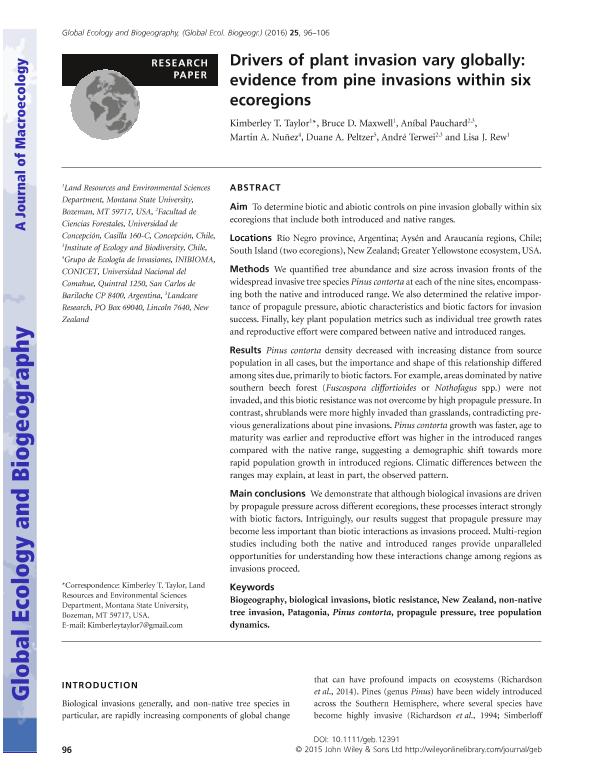Artículo
Drivers of plant invasion vary globally: Evidence from pine invasions within six ecoregions
Taylor, Kimberley T.; Maxwell, Bruce D.; Pauchard, Aníbal; Nuñez, Martin Andres ; Peltzer, Duane A.; Terwei, André; Rew, Lisa J.
; Peltzer, Duane A.; Terwei, André; Rew, Lisa J.
 ; Peltzer, Duane A.; Terwei, André; Rew, Lisa J.
; Peltzer, Duane A.; Terwei, André; Rew, Lisa J.
Fecha de publicación:
01/2016
Editorial:
Wiley Blackwell Publishing, Inc
Revista:
Global Ecology and Biogeography
ISSN:
1466-822X
Idioma:
Inglés
Tipo de recurso:
Artículo publicado
Clasificación temática:
Resumen
Aim: To determine biotic and abiotic controls on pine invasion globally within six ecoregions that include both introduced and native ranges. Locations: Río Negro province, Argentina; Aysén and Araucanía regions, Chile; South Island (two ecoregions), New Zealand; Greater Yellowstone ecosystem, USA. Methods: We quantified tree abundance and size across invasion fronts of the widespread invasive tree species Pinus contorta at each of the nine sites, encompassing both the native and introduced range. We also determined the relative importance of propagule pressure, abiotic characteristics and biotic factors for invasion success. Finally, key plant population metrics such as individual tree growth rates and reproductive effort were compared between native and introduced ranges. Results: Pinus contorta density decreased with increasing distance from source population in all cases, but the importance and shape of this relationship differed among sites due, primarily to biotic factors. For example, areas dominated by native southern beech forest (Fuscospora cliffortioides or Nothofagus spp.) were not invaded, and this biotic resistance was not overcome by high propagule pressure. In contrast, shrublands were more highly invaded than grasslands, contradicting previous generalizations about pine invasions. Pinus contorta growth was faster, age to maturity was earlier and reproductive effort was higher in the introduced ranges compared with the native range, suggesting a demographic shift towards more rapid population growth in introduced regions. Climatic differences between the ranges may explain, at least in part, the observed pattern. Main conclusions: We demonstrate that although biological invasions are driven by propagule pressure across different ecoregions, these processes interact strongly with biotic factors. Intriguingly, our results suggest that propagule pressure may become less important than biotic interactions as invasions proceed. Multi-region studies including both the native and introduced ranges provide unparalleled opportunities for understanding how these interactions change among regions as invasions proceed.
Archivos asociados
Licencia
Identificadores
Colecciones
Articulos(INIBIOMA)
Articulos de INST. DE INVEST.EN BIODIVERSIDAD Y MEDIOAMBIENTE
Articulos de INST. DE INVEST.EN BIODIVERSIDAD Y MEDIOAMBIENTE
Citación
Taylor, Kimberley T.; Maxwell, Bruce D.; Pauchard, Aníbal; Nuñez, Martin Andres; Peltzer, Duane A.; et al.; Drivers of plant invasion vary globally: Evidence from pine invasions within six ecoregions; Wiley Blackwell Publishing, Inc; Global Ecology and Biogeography; 25; 1; 1-2016; 96-106
Compartir
Altmétricas



